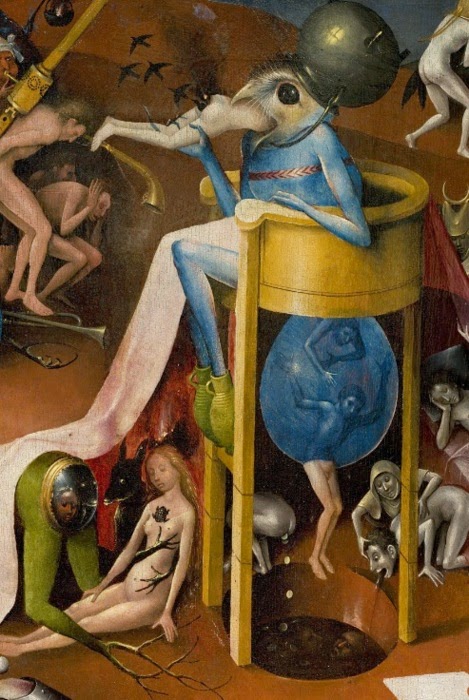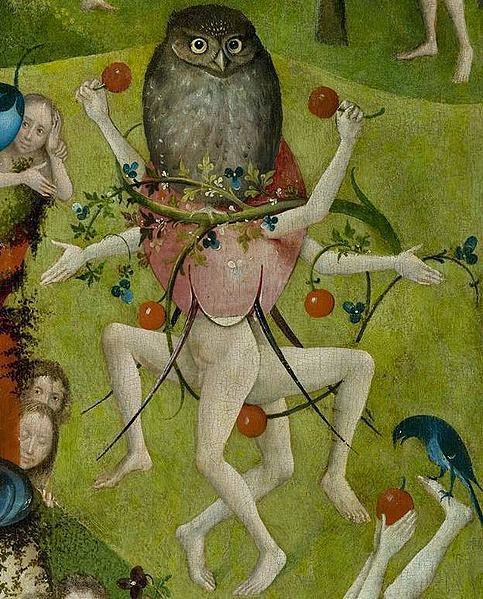Paris lay still below them.
From where Sophie stood, with both her hands wrapped round the neck of a carved
saint, it was a mass of silver, except where the river shone a rusty-gold
colour in the lamplight. (p.224)
The way she adds the 'rusty-gold' to the 'mass of silver' - what a lovely contrast of warm and cold metals... and look at those tiny yellow specks from 'the lamplight', which you can just see, can't you, on the surface of the Seine?
I love the fact that it's a child seeing all this from above, from a place that people generally don't go to, and that she's there with her arms hugging a stern, stone figure - as if trying to give it the affection it's never had. For me, it's this painting:
 |
| Gustave Caillebotte, Rue Halévy (1878) |
 | |
| Bosch, The Garden of Earthly Delights (1490?) |
 |
| charming |
 |
| it's a story full of Boschian owls, that's all I can remember... |
Generally, it happens with very famous rather than obscure works of art, perhaps because those tend to stick in one's head more. In children's literature, here are other associations, personal and therefore not always logical, though some are much more obvious than others:
 |
| Lois Lowry's The Giver and the 1956 French film The Red Balloon |
 |
| Malorie Blackman's Noughts and Crosses and Norman Rockwell's 'The Problem We All Live With' (1964) |
Sally Gardner's Maggot Moon is Anselm Kiefer all the way. Anne Fine's The Tulip Touch is this Edward Hopper...:
 |
| yep, it's the Bates Motel, too... not a coincidence, I'm sure. |
I didn't like Neil Gaiman's Coraline very much (sorry), but it was Louise Bourgeois's 'Maman' spiders:
Some authors make explicit reference to paintings, films or other visual art forms, like Marcus Sedgwick in Midwinterblood. I love that - I love looking up the works of art mentioned in books, especially when I have no clue what they are and it throws a completely new light on the text. Some painters, some paintings and some movements seem to crystallise writers' attention. Da Vinci, of course, but also the Surrealists in general, it seems.
Similarly, when I write, I never really picture my characters in my head, but there's always a lot of colours, and many static images, like paintings or stills from films or photographs. Fun adventure stories, whether I write them or read them, look quite like Sonia Delaunay's circles and spirals:
 |
| Pippi Longstocking! |
_____________________________________
Clementine Beauvais writes children's books in French and English. The former are of all kinds and shapes, and the latter humour/adventure series - the Sesame Seade mysteries with Hodder, the Holy-Moly Holiday series with Bloomsbury. She blogs here about children's literature and academia and is on Twitter @blueclementine.



3 comments:
Thank you for this. It's always fascinating to learn something of how other writers think and imagine.
I can't say that I make any connection with art - unless I'm deliberately looking for some detail of clothing or equipment from the past.
And I can't imagine reading or writing without the scene being projected on some inner screen. Nor could I ever write about a character without knowing what they look like and how they move - because I have to be able to see them. At the very least I have some vague idea of height, colouring, build. Often I 'cast' them.
Art galleries are stimulating and wonderful places to browse when you feel ideas are low. They always seem to be whispering "stories", though that is rather unfair on the artists. A strong visual image - real or imagined - can hold together the writing of a story. Or poem. Really nice post.
This was a brilliantly delicious post, Clementine. I'm sorry I missed it on the day but its just as wonderful in retrospect. I was a children's art teacher in another life and also see things in images but I'd never made quite so strong a comparison as you do.
I think part of the success of Donna Tart's The Goldfinch, for me, was that this was an actual painting... and such an intimate small painting that it seemed the perfect image to encapsulate the boy's life... caged by circumstances and caged by the painting as well.
Thank you for a fascinating blog.
Post a Comment